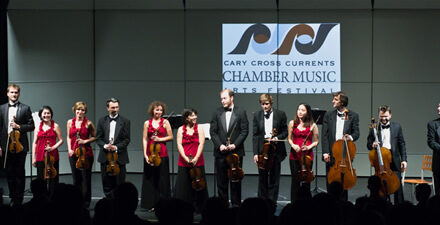I have heard the name of Dorothy Papadakos before, though I have not paid much attention to it. I knew she had been Cathedral Organist at the Cathedral of St. John the Divine in NYC for some years and had “retired”. The picture in my mind was of a graying, prim, serious woman, now touring as an organ recitalist. The concert at Edenton Street United Methodist Church on Wednesday, July 13 set all that straight in a most pleasurable way. Papadakos is thirty-something and definitely not graying, she is trim but not prim, and she may be a serious musician, but she comes equipped with a vivacious personality and a lively sense of humor displayed in her introductions and in her outstanding technical and interpretive skills on the king of instruments.
The keyboard of the Moller organ at ESUMC was displayed on the wall at the front of the nave, via closed-circuit television. The camera, focused over the shoulder of the artist, provided a unique and intimate involvement in the performance. The concert was a cooperative effort of the Church’s Heart of Raleigh concert series and the Royal School of Church Music in America, meeting at several venues in Raleigh and Durham this week.
Papadakos choose Aaron Copland’s “Fanfare for the Common Man” as her opener. It provided an opportunity to put the organ’s fine trumpet stops on display and also gave an interesting perspective on this well-known piece of Americana. Then we were treated to the Toccata in B Minor by the French master Eugene Gigout. He was best known for his masterful improvisations and for the school he founded in Paris, which produced many extraordinary organists. Next was the Allegro first movement of the Concerto in A Minor of Antonio Vivaldi as transcribed by J. S. Bach. It was, like most of Vivaldi’s music, lively and melodic, and it was entrancingly played by Papadakos.
The mood of the recital changed with a set of four improvisations the artist chose to illustrate the organ’s ability to dance. “Shall we Dance” included the Rodgers and Hammerstein’s song of the same name from The King and I, a Brazilian bossa nova, an Argentinean tango, and the Sirtáki from Zorba the Greek. The fingers danced on the keys, the toes, on the pedals, and the audience was swaying.
An instrument designed to detect underwater threats in the Cold War recorded the incredible sound of humpback whales, multiple octaves in range, eerie and fascinating in intonation. With these songs as the thematic material Papadakos added mystical organ support and interplay for what can only be described as an ethereal and extraordinary experience. She calls it “Deep Blue Improvisation.”
After a few comments on improvisation – the art of making up or extending music on the spot – and sharing a couple of stories about the challenges the improvisationist must deal with, Papadakos was given the names of two hymns out of which to weave her magic. After playing the tune(s) and a few moments of thoughtful preparation, she placed her fingers on the instrument and out came variations, reharmonization, reconstruction of the melody and a perfectly beautiful organ prelude, postlude, or interlude.
The final set was titled “The Fabulous 40s” and included improvisations on “I Got Rhythm” and “I Got a Crush on You” by George Gershwin, “The Best is Yet to Come” by Cy Coleman and “In the Mood” by Joe Garland. The organ danced, swung, bopped, and delighted the audience which consisted largely of professional church organists and a few others who love the sound of the pipes. For an encore, Papadakos played a couple of choruses of “Carolina in the Morning,” and the audience agreed that nothing could be finer.











